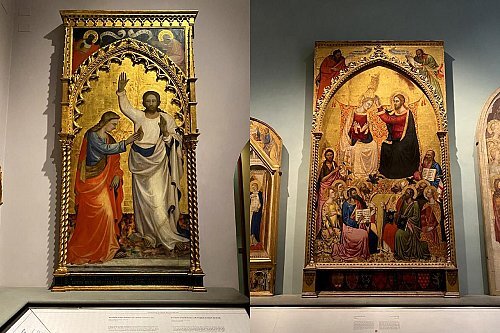Quarto de Pacino

Pintura gótica florentina
A última seção do piso térreo da galeria é dedicada à pintura gótica florentina e está dividida em três salas: uma apresenta obras do século XIII e início do século XIV, outra de artistas giottescos e a terceira de Orcagna com seus irmãos. Sala após sala, estes retábulos com fundo dourado absolutamente espetaculares provêm de grandes igrejas e conventos florentinos há muito fechados. As cores brilhantes das recentes restaurações dão as boas-vindas a alguns dos temas mais populares do século XIV, tal como acolhiam os peregrinos ou os mercadores que se tornavam patronos.
O núcleo das obras mais antigas expostas na Galleria dell'Accademia encontra-se nesta primeira sala. Aqui abundam pinturas góticas, todas em madeira: um crucifixo pintado (adorno típico do altar-mor) proveniente de igrejas, com os habituais polípticos e Majestades no mesmo estilo que se encontram em quase todos os altares laterais, juntamente com santos mártires criados para fins educativos e devocionais — para ajudar a contar as suas histórias de fé.
O painel maior da sala é uma elaborada e encantadora cruz da Árvore da Vida pintada por Pacino di Bonaguida. Representa a Árvore da Vida. A pintura estava inicialmente num convento de freiras clarissas em Florença. De acordo com o Apocalipse, esta árvore denota a salvação e dá um dom à humanidade, representado pelos seus frutos e pelos seus doze ramos.
Os tondos suspensos nestes ramos contam os acontecimentos da vida de Cristo, ou melhor, a sua Paixão e Glória. Na parte inferior, a árvore está enraizada no Jardim do Éden, onde se vêem cenas do Génesis, que narram a Criação, incluindo as vidas de Adão e Eva. Da esquerda para a direita, nos quatro cantos da base, encontram-se figuras ajoelhadas/sentadas, incluindo Moisés, São Francisco, Santa Clara e João Evangelista. Acima, há uma cúspide que mostra a corte celestial do Céu; no centro, Cristo entronizado com a Virgem Maria - ambos rodeados por anjos vermelhos, santos e profetas - entre a cruz e o Céu, um pelicano perfura o peito para alimentar os filhotes com o seu sangue, simbolizando a salvação da humanidade através do sacrifício de Cristo na cruz pela humanidade. Em suma, este é um exemplo que revela detalhes bastante requintados, destinados a mostrar não só a habilidade técnica de Pacino di Buonaguida como pintor, mas também como iluminador, que teria sido muito procurado quando este tipo de trabalho precisava ser feito!

